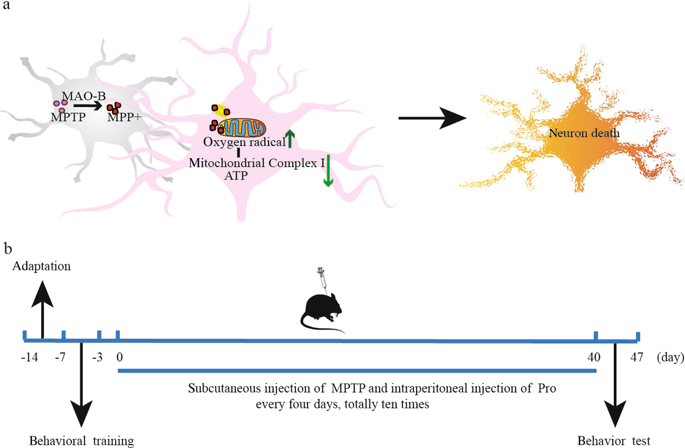当前位置:
X-MOL 学术
›
Acta Pharmacol. Sin.
›
论文详情
Our official English website, www.x-mol.net, welcomes your
feedback! (Note: you will need to create a separate account there.)
NLRP3 inflammasome pathway is involved in olfactory bulb pathological alteration induced by MPTP.
Acta Pharmacologica Sinica ( IF 6.9 ) Pub Date : 2019-02-06 , DOI: 10.1038/s41401-018-0209-1 Ying Chen 1 , Qiu-Shuang Zhang 1 , Qian-Hang Shao 1 , Shuo Wang 1 , Yu-He Yuan 1 , Nai-Hong Chen 1 , Hong-Bo Wang 2
Acta Pharmacologica Sinica ( IF 6.9 ) Pub Date : 2019-02-06 , DOI: 10.1038/s41401-018-0209-1 Ying Chen 1 , Qiu-Shuang Zhang 1 , Qian-Hang Shao 1 , Shuo Wang 1 , Yu-He Yuan 1 , Nai-Hong Chen 1 , Hong-Bo Wang 2
Affiliation

|
Olfactory bulb, as one of sensory organs opening to the outside, is susceptible to toxic environment and easy to deteriorate. Recent studies in Parkinson's disease (PD) patients and 1-methyl-4-phenyl-1,2,3,6-tetrahydropyridine (MPTP)-treated monkeys have shown that abnormal α-synuclein is accumulated in the olfactory glomeruli, suggesting that the lesions of PD are not only confined to the substantia nigra (SN) but also located in the olfactory bulb. Thus, olfactory bulb might be the region of onset in PD pathogenesis and a targeted region for diagnosis and treatment of PD. However, the relationship between olfactory bulb and pathogenesis of PD remains unclear. In the present study, we investigated the inflammatory pathological alterations in olfactory bulb and the underlying mechanisms in chronic MPTP mice. Mice were treated with MPTP/P, i.e., MPTP (25 mg/kg, s.c.) plus probenecid (250 mg/kg, i.p.) every 4 days, for ten times. The mice displayed typical parkinsonian syndrome. Then we examined their olfactory function and the pathologic changes in olfactory bulb. The mice showed obvious olfactory dysfunction in a buried pellet test. Immunohistochemical studies revealed that tyrosine hydroxylase (TH) protein levels were significantly decreased, whereas abnormal α-synuclein was significantly increased in the olfactory bulbs. Furthermore, the olfactory bulbs in MPTP/P-treated mice showed significantly increased levels of interleukin-1β (IL-1β), caspase-1, glial fibrillary acidic protein (GFAP), Toll receptor 4 (TLR4), phosphorylation of p65, as well as activated molecules of NOD-like receptor protein 3 (NLRP3) that were associated with neuroinflammation. Our results demonstrate that MPTP/P-caused olfactory bulb damage might be related to NLRP3-mediated inflammation.
中文翻译:

NLRP3炎性体通路参与了MPTP诱导的嗅球病理改变。
嗅球作为对外开放的感觉器官之一,易受有毒环境影响,易变质。最近对帕金森病 (PD) 患者和 1-甲基-4-苯基-1,2,3,6-四氢吡啶 (MPTP) 治疗的猴子的研究表明,异常的 α-突触核蛋白在嗅觉肾小球中积累,这表明PD的病变不仅局限于黑质(SN),而且位于嗅球。因此,嗅球可能是帕金森病发病的发病区域,也是帕金森病诊断和治疗的靶区。然而,嗅球与 PD 发病机制之间的关系仍不清楚。在本研究中,我们研究了慢性 MPTP 小鼠嗅球的炎症病理改变和潜在机制。用 MPTP/P 处理小鼠,即 MPTP (25 mg/kg, sc) 加丙磺舒 (250 mg/kg, ip) 每 4 天一次,共 10 次。小鼠表现出典型的帕金森综合征。然后我们检查了它们的嗅觉功能和嗅球的病理变化。在埋藏颗粒试验中,小鼠表现出明显的嗅觉功能障碍。免疫组织化学研究表明,酪氨酸羟化酶 (TH) 蛋白水平显着降低,而嗅球中异常的 α-突触核蛋白显着增加。此外,MPTP/P 处理小鼠的嗅球显示白细胞介素 1β (IL-1β)、caspase-1、胶质纤维酸性蛋白 (GFAP)、Toll 受体 4 (TLR4)、p65 磷酸化水平显着增加,如以及与神经炎症相关的 NOD 样受体蛋白 3 (NLRP3) 的活化分子。
更新日期:2019-02-06
中文翻译:

NLRP3炎性体通路参与了MPTP诱导的嗅球病理改变。
嗅球作为对外开放的感觉器官之一,易受有毒环境影响,易变质。最近对帕金森病 (PD) 患者和 1-甲基-4-苯基-1,2,3,6-四氢吡啶 (MPTP) 治疗的猴子的研究表明,异常的 α-突触核蛋白在嗅觉肾小球中积累,这表明PD的病变不仅局限于黑质(SN),而且位于嗅球。因此,嗅球可能是帕金森病发病的发病区域,也是帕金森病诊断和治疗的靶区。然而,嗅球与 PD 发病机制之间的关系仍不清楚。在本研究中,我们研究了慢性 MPTP 小鼠嗅球的炎症病理改变和潜在机制。用 MPTP/P 处理小鼠,即 MPTP (25 mg/kg, sc) 加丙磺舒 (250 mg/kg, ip) 每 4 天一次,共 10 次。小鼠表现出典型的帕金森综合征。然后我们检查了它们的嗅觉功能和嗅球的病理变化。在埋藏颗粒试验中,小鼠表现出明显的嗅觉功能障碍。免疫组织化学研究表明,酪氨酸羟化酶 (TH) 蛋白水平显着降低,而嗅球中异常的 α-突触核蛋白显着增加。此外,MPTP/P 处理小鼠的嗅球显示白细胞介素 1β (IL-1β)、caspase-1、胶质纤维酸性蛋白 (GFAP)、Toll 受体 4 (TLR4)、p65 磷酸化水平显着增加,如以及与神经炎症相关的 NOD 样受体蛋白 3 (NLRP3) 的活化分子。











































 京公网安备 11010802027423号
京公网安备 11010802027423号